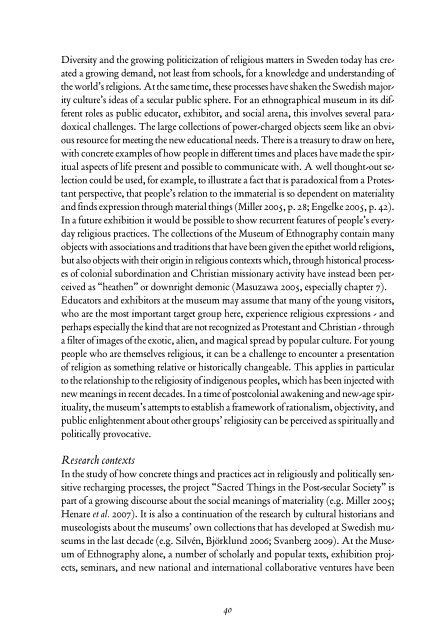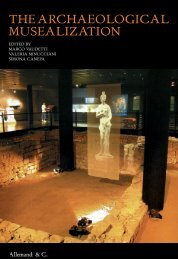RELIGION AND MUSEUMS - Allemandi
RELIGION AND MUSEUMS - Allemandi
RELIGION AND MUSEUMS - Allemandi
Create successful ePaper yourself
Turn your PDF publications into a flip-book with our unique Google optimized e-Paper software.
Diversity and the growing politicization of religious matters in Sweden today has createda growing demand, not least from schools, for a knowledge and understanding ofthe world’s religions. At the same time, these processes have shaken the Swedish majorityculture’s ideas of a secular public sphere. For an ethnographical museum in its differentroles as public educator, exhibitor, and social arena, this involves several paradoxicalchallenges. The large collections of power-charged objects seem like an obviousresource for meeting the new educational needs. There is a treasury to draw on here,with concrete examples of how people in different times and places have made the spiritualaspects of life present and possible to communicate with. A well thought-out selectioncould be used, for example, to illustrate a fact that is paradoxical from a Protestantperspective, that people’s relation to the immaterial is so dependent on materialityand finds expression through material things (Miller 2005, p. 28; Engelke 2005, p. 42).In a future exhibition it would be possible to show recurrent features of people’s everydayreligious practices. The collections of the Museum of Ethnography contain manyobjects with associations and traditions that have been given the epithet world religions,but also objects with their origin in religious contexts which, through historical processesof colonial subordination and Christian missionary activity have instead been perceivedas “heathen” or downright demonic (Masuzawa 2005, especially chapter 7).Educators and exhibitors at the museum may assume that many of the young visitors,who are the most important target group here, experience religious expressions - andperhaps especially the kind that are not recognized as Protestant and Christian - througha filter of images of the exotic, alien, and magical spread by popular culture. For youngpeople who are themselves religious, it can be a challenge to encounter a presentationof religion as something relative or historically changeable. This applies in particularto the relationship to the religiosity of indigenous peoples, which has been injected withnew meanings in recent decades. In a time of postcolonial awakening and new-age spirituality,the museum’s attempts to establish a framework of rationalism, objectivity, andpublic enlightenment about other groups’ religiosity can be perceived as spiritually andpolitically provocative.Research contextsIn the study of how concrete things and practices act in religiously and politically sensitiverecharging processes, the project “Sacred Things in the Post-secular Society” ispart of a growing discourse about the social meanings of materiality (e.g. Miller 2005;Henare et al. 2007). It is also a continuation of the research by cultural historians andmuseologists about the museums’ own collections that has developed at Swedish museumsin the last decade (e.g. Silvén, Björklund 2006; Svanberg 2009). At the Museumof Ethnography alone, a number of scholarly and popular texts, exhibition projects,seminars, and new national and international collaborative ventures have been40







